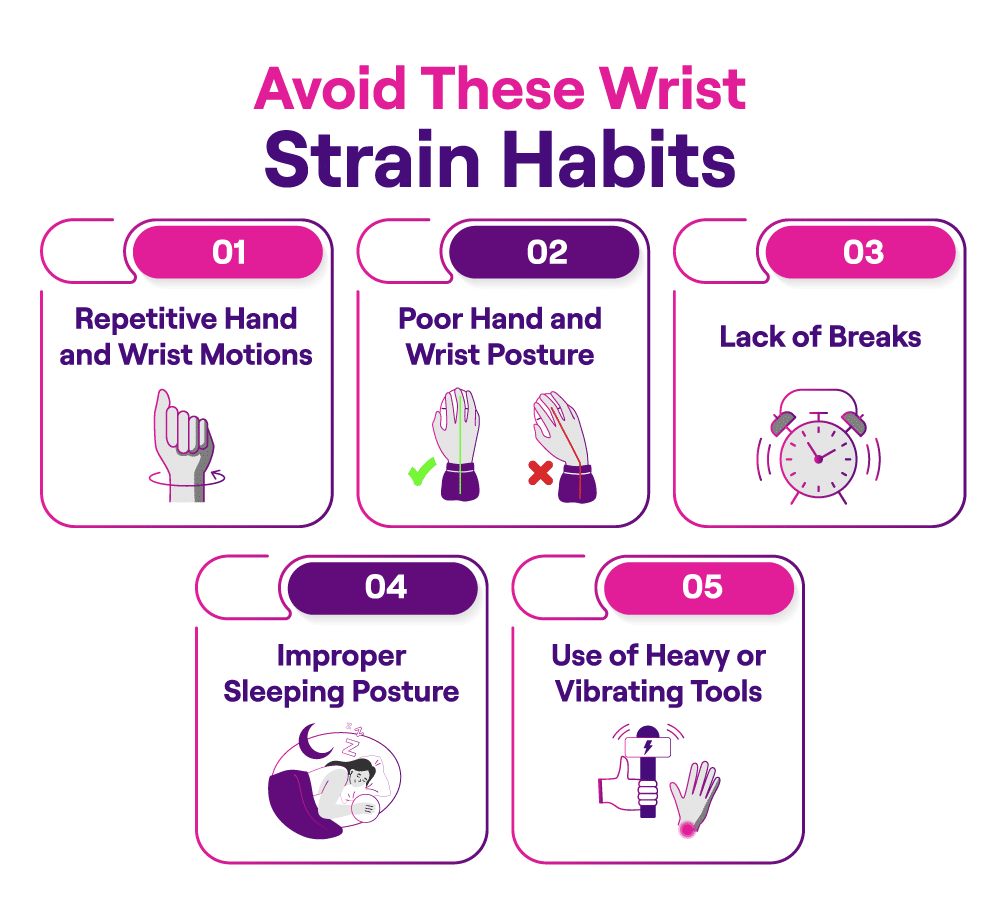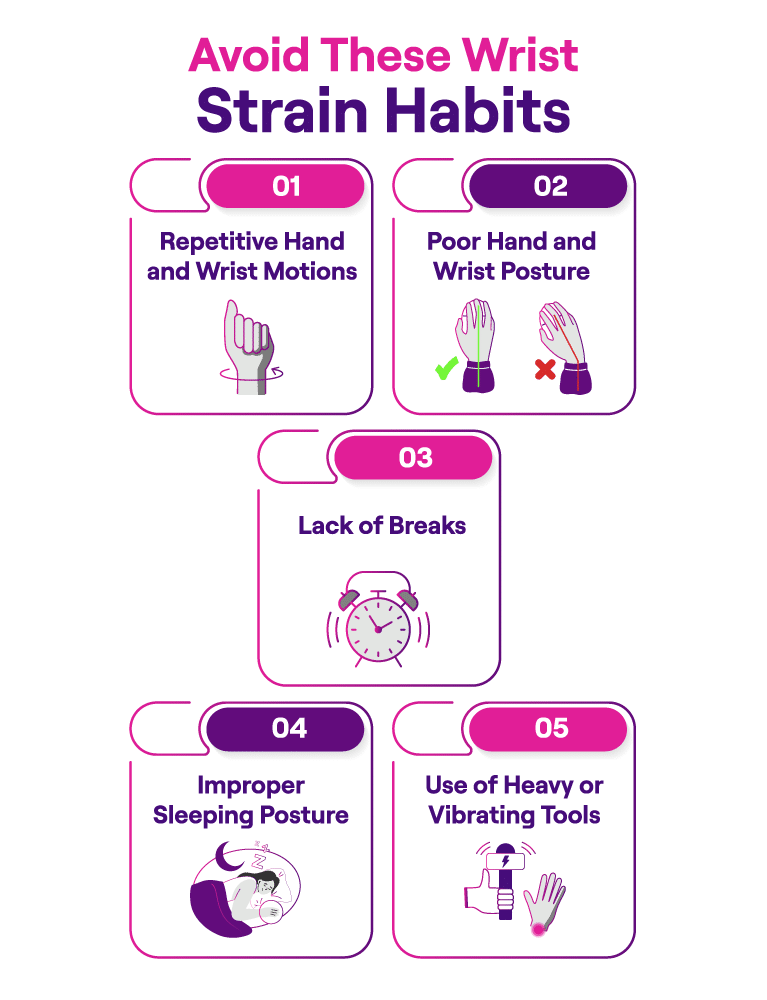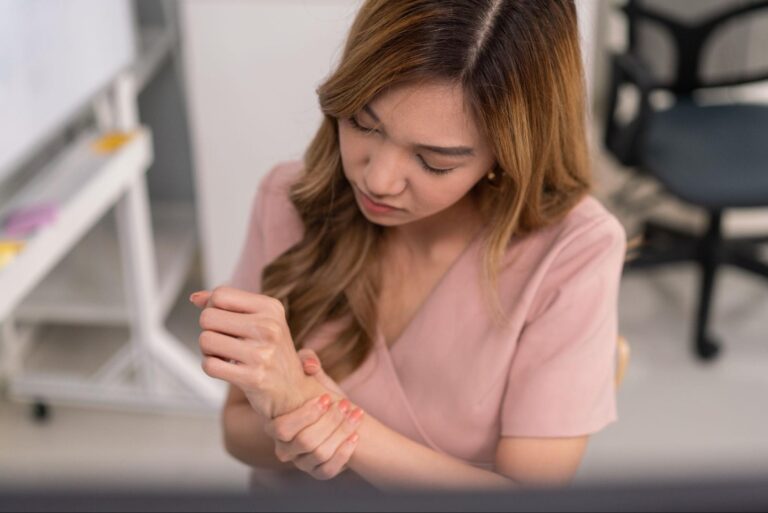Carpal tunnel syndrome (CTS) can make everyday tasks challenging, with symptoms like tingling, numbness, pain, and weakness interfering with your ability to use your hands comfortably. These symptoms develop when the median nerve, which passes through a narrow tunnel in your wrist known as the carpal tunnel, becomes compressed due to swelling or increased pressure. Even minor irritations in this confined space may lead to noticeable discomfort—especially given the tight nature of the area and its susceptibility to strain.
Fortunately, small changes to your daily routine may help minimize stress on your median nerve and prevent existing symptoms from worsening. Habits such as improper wrist alignment, repetitive motions, or prolonged strain often add up over time, making it critical to be mindful of how you engage your hands and wrists during work, hobbies, and rest.
The following guide explores habits that may worsen CTS symptoms, as well as practical tips for protecting your wrists from unnecessary strain. We also detail the benefits of early detection and minimally invasive procedures, and the role of imaging techniques like ultrasound in diagnosing CTS.
Understanding Carpal Tunnel Syndrome (CTS)
Let’s explore the different stages of CTS, which arise when the median nerve in your wrist experiences excessive pressure as it travels through the carpal tunnel. The carpal tunnel is a narrow passageway composed of bones and ligaments in the wrist. Any swelling in this confined space may create compression on the median nerve, leading to discomfort and functional limitations. Left unaddressed, this compression can escalate, impacting hand and wrist function over time.
According to the National Center for Biotechnology Information, CTS is often regarded as the most common nerve condition. This further highlights the importance of awareness and early intervention.
What Causes CTS?
Several factors may contribute to the development of carpal tunnel syndrome, often linked to repetitive strain, medical conditions, or anatomical variations. Key contributors include:
- Repetitive or forceful hand movements: Tasks such as typing, playing an instrument, or using tools in assembly-line jobs can lead to overuse and strain in the wrist. In some cases, these activities can trigger CTS by increasing pressure inside the tunnel.
- Pregnancy-related swelling: Hormonal changes during pregnancy can increase fluid retention, which may cause swelling in the carpal tunnel and prompt early signs recognized by a Mayo Clinic resource.
- Chronic health conditions: Issues like diabetes, obesity, or thyroid disorders may heighten susceptibility to CTS by promoting nerve damage or tissue inflammation.
- Unique anatomical structures: Individuals with a smaller or more restrictive carpal tunnel may naturally experience more pressure on the median nerve.
Additionally, the National Institute of Arthritis and Musculoskeletal and Skin Diseases offers resources detailing risk factors and potential strategies for individuals concerned about developing CTS.
Recognizing CTS Symptoms
Early awareness of CTS may help you respond promptly with preventative measures. Common symptoms may include:
- Numbness or tingling: Often in the thumb, index, and middle fingers.
- Pain: May remain localized in the wrist or travel into the forearm.
- Weakness: Grip strength may decline, making tasks like holding objects more difficult.
- Nighttime discomfort: Tingling or burning sensations can interfere with sleep and sometimes worsen by morning.
These symptoms often start gradually but may intensify over time if left unattended.
The Value of Early Evaluation
Prompt evaluation of CTS symptoms may allow you to manage the condition before nerve damage becomes more pronounced. A healthcare provider may use various approaches, such as wrist splints, lifestyle adjustments, or imaging methods, to gain clarity on your situation. Diagnostic ultrasound offers a real-time look at the median nerve, can be quicker and more cost-effective than other imaging, and is painless and patient-friendly.1
Early detection can make it possible to avoid extended nerve compression and potential long-term damage.
Bad Habits That Can Worsen CTS Symptoms


CTS symptoms may be worsened by habits that place strain on the wrist. These harmful behaviors may be more prevalent in certain occupations, but they can pop up in many daily activities that require repetitive hand motions. Some of the most common habits that contribute to CTS include:
Repetitive Hand and Wrist Motions
Consistently performing the same hand and wrist movements—such as typing, sewing, or assembly-line work—can gradually lead to tissue inflammation in the carpal tunnel. The repetitive flexion and extension of the wrist during these tasks increases pressure within the already narrow space, compressing the median nerve. Over time, this strain can result in tingling, numbness, or other CTS indicators.
High-force activities, like gripping tools or objects tightly throughout the day, further exacerbate this issue. The combination of repetitive motion and forceful effort compounds the stress on the nerve, often intensifying any discomfort. Data from the Bureau of Labor Statistics indicates that repetitive strain injuries remain a notable source of lost work time.
Poor Hand and Wrist Posture
Improper wrist posture may reduce the space available inside the carpal tunnel, potentially increasing nerve compression. This frequently occurs when wrists are bent awkwardly—for example, while typing with wrists held at an unnatural angle. Misalignment between the hand and forearm can also add strain during tasks like lifting or handling objects.
Additionally, resting wrists on hard or uneven surfaces—like the edge of a desk—can position the wrist unfavorably. While direct research linking these postures to irreversible nerve compression is limited, many ergonomic guidelines recommend supportive rest pads or improved desk setups to reduce potential strain.
Lack of Breaks During Repetitive Tasks
Diving into repetitive work without breaks can create tension in the wrists and hands. Activities requiring the same motions repeatedly reduce circulation to the area, which may cause swelling around the median nerve. Without rest, these tissues remain inflamed, compounding any existing compression.
Regular intervals to stretch and reset your posture are crucial. Failing to incorporate brief pauses could lead even mild discomfort to escalate over time.
Sleeping Habits That Strain the Wrist
Your sleeping posture may also worsen CTS symptoms. Many people unconsciously bend their wrists or tuck their hands under their bodies at night, putting prolonged pressure on the median nerve. Waking with stiff, tingling, or numb hands is a common sign that this positioning is contributing to nerve compression.
Keeping the wrist neutral during sleep—using a small wrist brace or supportive pillow—may help alleviate this issue. Avoid pressing your wrists against hard surfaces, as tension built up overnight can linger the next day, worsening discomfort.
Use of Heavy or Vibrating Tools Without Precaution
Tools that vibrate or require ongoing forceful grip can aggravate median nerve compression. Over time, this repetitive stress may elevate the likelihood of developing CTS or intensifying existing symptoms.
When you do use these types of tools, ensure you employ precautions—such as taking regular breaks and wearing vibration-dampening gloves—to keep nerve pressure in check. Without these measures, you might inadvertently strain the nerve and surrounding tissues.
By recognizing factors that worsen CTS, you can fine-tune daily activities to reduce hand and wrist stress. Simple shifts—like monitoring wrist alignment or scheduling short rest periods—may help protect your hands from undue pressure.
Take A Symptom Survey
Practical Tips to Mitigate CTS Symptoms
Protecting your wrists doesn’t have to be complicated. By applying a few targeted strategies, you can minimize stress on the median nerve and potentially reduce discomfort. These practical adjustments may benefit anyone concerned about maintaining optimal wrist function over time.
Ergonomic Adjustments at Work and Home
Ergonomics play a central role in reducing wrist strain—whether you’re at a desk job, working on hobbies, or handling household tasks. Consider:
- Optimize your workstation: Adjust your chair so wrists and forearms are parallel to the floor when typing. An adjustable keyboard tray helps keep wrists in a neutral position.
- Choose appropriate tools: Use a computer mouse and keyboard designed to support wrist alignment, and employ soft wrist pads for gentle backing, without applying direct pressure on the carpal tunnel.
- Ergonomic utensils: For tasks like cooking or gardening, use tools with padded or contoured grips to ease tension on the hands and wrists.
- Review official guidelines: The Occupational Safety and Health Administration guidelines also offer valuable insights on organizing your workstation to help reduce wrist and hand strain.
Even minor improvements in ergonomics may support long-term wrist health and relieve repetitive stress.
Reducing Repetitive Strain
Repeating the same hand motions over long periods can exacerbate CTS symptoms. To lessen repetitive strain:
- Task rotation: Vary activities every 20–30 minutes if possible, giving wrist muscles a chance to rest.
- Micro-breaks: Stretch wrists and fingers periodically, rotate forearms, or briefly shake out your hands to maintain circulation.
- Regular stretching: Include forearm stretches alongside shoulder and upper-back exercises, since tension in these areas can impact wrist alignment.
These small changes may help mitigate the cumulative effects of repeated hand motions.
Managing Stress to Ease Muscle Tension
Stress frequently tightens muscles in the shoulders, arms, and wrists, potentially exacerbating CTS. Combat stress by:
- Practicing relaxation methods: Yoga, meditation, or brief breathing exercises may reduce overall muscle tension.
- Maintaining good posture: Slouching or hunching may contribute to tension in the upper body, so focus on keeping shoulders relaxed and your spine comfortably aligned.
A relaxed upper body can indirectly lessen strain on the wrists, particularly during repetitive tasks.
Prioritizing Wrist Position During Sleep
Since many people bend or twist their wrists unconsciously at night, sleep adjustments can be pivotal:
- Wear a light wrist brace: A brace that encourages a neutral wrist position may reduce median nerve compression.
- Use supportive bedding: Pillows or rolled towels can support your arms, limiting the chance of placing direct weight on your wrists.
- Avoid tight sleeping positions: Steer clear of curling your hand under your head or body, as it can restrict blood flow and irritate the nerve.
Adjusting overnight habits may alleviate morning stiffness and discomfort related to CTS.
Protecting Wrists During Tool Use
If your work or daily tasks involve heavy or vibrating tools, be proactive in reducing wrist stress:
- Use vibration-dampening gloves: These can reduce the impact on your hands from long-term tool use.
- Adopt a lighter grip: Grasp tools only as firmly as needed. Over-gripping increases stress on the median nerve.
- Pick ergonomic designs: Tools that contour to your hand size or feature padded handles may ease prolonged exertion.
- Take breaks: Frequent rest periods allow muscles to recover and help curb cumulative strain.
With these measures in place, the median nerve experiences less pressure, potentially reducing discomfort.
Find A Physician Near You
Early Diagnosis and Modern Techniques
If carpal tunnel syndrome symptoms persist or disrupt daily life, early professional assessment may help you find viable approaches that address median nerve compression before severe damage can occur. Timely identification enables you to maintain productivity and comfort.
Why Early Detection Matters
When bothersome CTS symptoms arise, consulting a healthcare professional can encourage a more positive long-term outcome:
- Avoid continuous nerve compression: Prompt intervention may prevent extended damage to the median nerve.
- Support daily activities: Solutions offered early may allow you to continue everyday routines with fewer interruptions.
- Leverage conservative methods: Splinting, activity changes, or other less involved steps may suffice if CTS is caught early.
Studies such as those supplied by the National Library of Medicine highlight the value of evaluating median nerve function and initiating management strategies in the initial stages of CTS.
The Role of Ultrasound in CTS Evaluation
Real-time imaging with ultrasound, when used to assess CTS, has several benefits1:
- Immediate visuals: Providers can see the median nerve and surrounding tissues on the spot.
- Efficient: Results are available without lengthy post-processing or lab analysis.
- Painless and patient-friendly: The process is not invasive, typically causing minimal to no discomfort.
- Less costly: It can be more affordable than other imaging methods in many settings.
- Nerve measurement: A provider may gauge nerve swelling by visualizing its cross-sectional area in real time.
This immediate feedback helps physicians tailor a plan that addresses your specific condition quickly.
Carpal Tunnel Release with Ultrasound Guidance (CTR-US)
If CTS symptoms are pronounced or resistant to more conservative measures, some individuals may explore carpal tunnel release with ultrasound guidance (CTR-US). This minimally invasive approach is performed in an office-based or clinic-based setting to address the underlying compression of the median nerve.2-3 Because CTR-US employs real-time ultrasound imaging, a provider may accurately navigate an instrument to relieve pressure in the carpal tunnel. This technique may be an option for those who have persistent CTS and are seeking to restore comfortable hand function.
Please discuss the risks and benefits of this procedure with your healthcare provider.
Implementing Long-term Solutions for Wrist Health
Living with hand discomfort can make even basic routines—like typing, gripping, or buttoning a shirt—feel daunting. By understanding and avoiding habits that contribute to unnecessary wrist strain, you may reduce the likelihood of further issues. Simple lifestyle adjustments—such as enhancing workplace ergonomics, allowing frequent rest breaks, and remembering to keep wrists neutral—may go a long way toward lessening symptoms and maintaining comfort.
Additionally, staying informed about early diagnostics may help you catch and address potential median nerve problems before they become overwhelming. Modern imaging methods, including ultrasound, often provide clarity quickly, and carpal tunnel release with ultrasound guidance (CTR-US) may be another office-based option if conservative strategies prove insufficient.
For more details on how to create a supportive environment that promotes healthy wrists, explore our in-depth guide on ergonomic practices. Seeking professional help for persistent or severe symptoms can be a valuable next step in ensuring a more comfortable path forward.
MP04199rA




